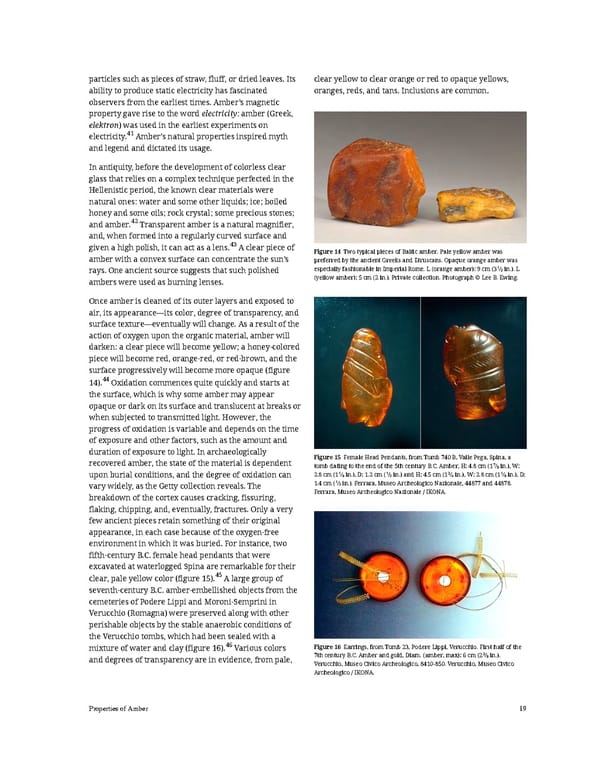particles such as pieces of straw, fluff, or dried leaves. Its clear yellow to clear orange or red to opaque yellows, ability to produce static electricity has fascinated oranges, reds, and tans. Inclusions are common. observers from the earliest times. Amber’s magnetic property gave rise to the word electricity: amber (Greek, elektron) was used in the earliest experiments on electricity.41 Amber’s natural properties inspired myth and legend and dictated its usage. In antiquity, before the development of colorless clear glass that relies on a complex technique perfected in the Hellenistic period, the known clear materials were natural ones: water and some other liquids; ice; boiled honey and some oils; rock crystal; some precious stones; and amber.42Transparent amber is a natural magnifier, and, when formed into a regularly curved surface and given a high polish, it can act as a lens.43 A clear piece of Figure 14 Two typical pieces of Baltic amber. Pale yellow amber was amber with a convex surface can concentrate the sun’s preferred by the ancient Greeks and Etruscans. Opaque orange amber was rays. One ancient source suggests that such polished especially fashionable in Imperial Rome. L (orange amber): 9 cm (31⁄2 in.). L ambers were used as burning lenses. (yellow amber): 5 cm (2 in.). Private collection. Photograph © Lee B. Ewing. Once amber is cleaned of its outer layers and exposed to air, its appearance—its color, degree of transparency, and surface texture—eventually will change. As a result of the action of oxygen upon the organic material, amber will darken: a clear piece will become yellow; a honey-colored piece will become red, orange-red, or red-brown, and the surface progressively will become more opaque (figure 14).44 Oxidation commences quite quickly and starts at the surface, which is why some amber may appear opaque or dark on its surface and translucent at breaks or when subjected to transmitted light. However, the progress of oxidation is variable and depends on the time of exposure and other factors, such as the amount and duration of exposure to light. In archaeologically Figure 15 Female Head Pendants, from Tomb 740 B, Valle Pega, Spina, a recovered amber, the state of the material is dependent tomb dating to the end of the 5th century B.C. Amber, H: 4.8 cm (17⁄8 in.), W: upon burial conditions, and the degree of oxidation can 2.8 cm (11⁄8 in.), D: 1.2 cm (1⁄2 in.) and H: 4.5 cm (13⁄4 in.), W: 2.8 cm (11⁄8 in.), D: vary widely, as the Getty collection reveals. The 1.4 cm (1⁄2 in.). Ferrara, Museo Archeologico Nazionale, 44877 and 44878. breakdown of the cortex causes cracking, fissuring, Ferrara, Museo Archeologico Nazionale / IKONA. flaking, chipping, and, eventually, fractures. Only a very few ancient pieces retain something of their original appearance, in each case because of the oxygen-free environment in which it was buried. For instance, two fifth-century B.C. female head pendants that were excavated at waterlogged Spina are remarkable for their clear, pale yellow color (figure 15).45 A large group of seventh-century B.C. amber-embellished objects from the cemeteries of Podere Lippi and Moroni-Semprini in Verucchio (Romagna) were preserved along with other perishable objects by the stable anaerobic conditions of the Verucchio tombs, which had been sealed with a mixture of water and clay (figure 16).46 Various colors Figure 16 Earrings, from Tomb 23, Podere Lippi, Verucchio. First half of the and degrees of transparency are in evidence, from pale, 7th century B.C. Amber and gold, Diam. (amber, max): 6 cm (23⁄8 in.). Verucchio, Museo Civico Archeologico, 8410-850. Verucchio, Museo Civico Archeologico / IKONA. Properties of Amber 19
 Ancient Carved Ambers in the J. Paul Getty Museum Page 28 Page 30
Ancient Carved Ambers in the J. Paul Getty Museum Page 28 Page 30